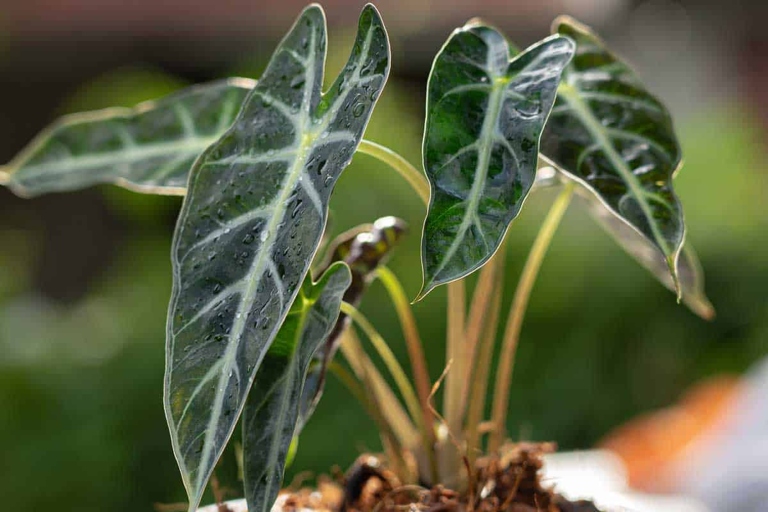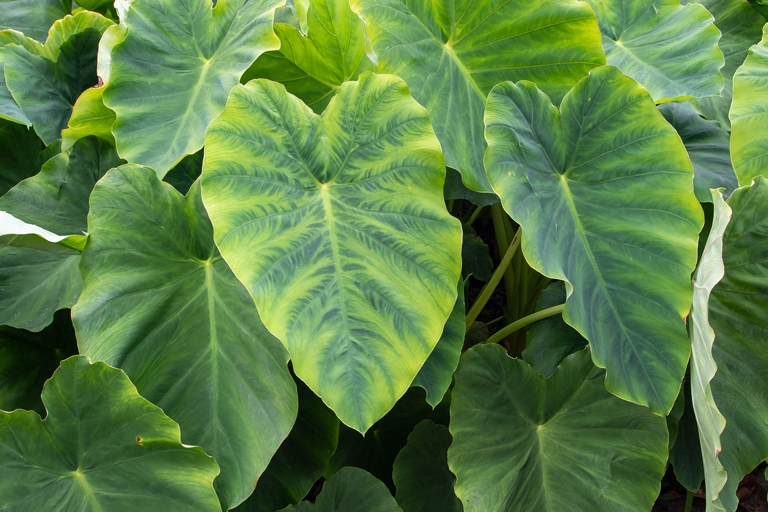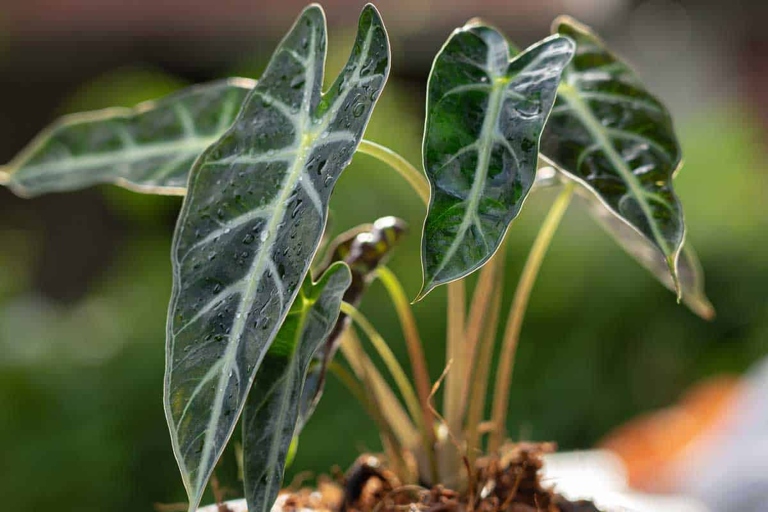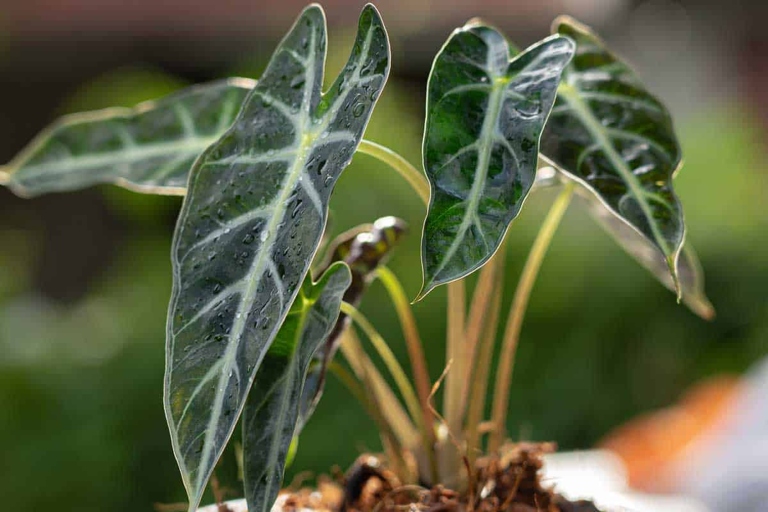If you have an elephant ear bulb that isn’t growing, don’t worry – you’re not alone. There are a number of reasons why this may be happening, and we’ve got six of them here. With a little troubleshooting, you should be able to get your bulb growing again in no time.
First Up – How Long Does It Take Elephant Ear Bulbs to Sprout?
Maybe the bulbs were old or damaged when you bought them. Or, you may not have planted them deep enough. If you’re wondering why your elephant ear bulbs aren’t growing, there are a few possible explanations.

It can also take a while for elephant ear bulbs to sprout. So, be patient and don’t give up hope if you don’t see them right away. They may not emerge from the ground for several weeks, or even months.
If you want to speed things up, you can try soaking the bulbs in water for a few days before planting them. This will help them to sprout more quickly.
Whatever the reason, there are a few things you can do to try to get your elephant ear bulbs to grow. With a little patience and care, you should see them sprouting in no time.
Reasons Why Elephant Ear Bulbs Are Not Growing
Here are some of the most common causes: If you have an elephant ear bulb that isn’t growing, there could be a few reasons why.
The bulb was not planted deep enough. 1. Elephant ear bulbs need to be planted about 8 inches deep in order to grow properly.

The soil is too dry. Elephant ear bulbs need to be kept in moist soil in order to grow. If the soil is too dry, the bulb will not be able to absorb the moisture it needs. 2.
The bulb was damaged when it was planted. 3. If the bulb was dropped or damaged in any way when it was being planted, it may not be able to grow properly.
The bulb was not given enough water. 4. Elephant ear bulbs need to be watered regularly in order to grow. If the bulb is not getting enough water, it will not be able to grow.
The bulb was not given enough light. If the bulb is not getting enough light, it will not be able to grow. Elephant ear bulbs need to be in an area that gets plenty of sunlight in order to grow. 5.
If you have an elephant ear bulb that isn’t growing, there are a few possible reasons why. If you still can’t get the bulb to grow, it may be damaged and you’ll need to get a new one. Be sure to check that the bulb was planted properly, the soil is moist, and the bulb is getting enough water and light.
[1] Soil Temperature is Too Cold, Causing Elephant Ear Bulbs Not to Grow
If your elephant ear bulbs are not growing, it may be because the soil temperature is too cold. Elephant ears need warm soil to grow, so if the temperature is below 60 degrees Fahrenheit, they will not grow. You can try putting a heat lamp over the area where you plant them, or you can wait until the weather warms up.
How to Fix
If you have an elephant ear bulb that isn’t growing, there are a few things you can do to try to fix the problem.

If your bulb is not getting enough light, move it to a sunnier spot. First, make sure that the bulb is getting enough light. Elephant ear bulbs need at least six hours of sunlight per day.
Water the bulb once a week, making sure to soak the soil thoroughly. Elephant ear bulbs need to be kept moist, but not wet. Second, make sure the bulb is getting enough water.
If your soil is poorly drained, add some sand or gravel to improve drainage. Elephant ear bulbs will rot if the soil is too wet. Third, make sure the soil is well-drained.
If the temperature drops below 60 degrees Fahrenheit, the bulb will not grow. Elephant ear bulbs need warm temperatures to grow. Fourth, make sure the bulb is not too cold.
If you have tried all of these things and the bulb still isn’t growing, it may be time to replace it. Elephant ear bulbs only last for a few years before they need to be replaced.
[2] Elephant Ear Bulbs Cannot Grow in Dry Soil
Unfortunately, elephant ear bulbs cannot grow in dry soil. If you live in an area with dry soil, you may be wondering if you can grow elephant ear bulbs. If the soil is too dry, the bulbs will not be able to absorb enough moisture and will not be able to grow. The reason for this is that elephant ear bulbs need a lot of moisture to grow.

If you can provide these conditions, you should be able to grow elephant ear bulbs in dry soil. You will also need to make sure that the soil is well-drained so that the bulbs do not sit in water. If you want to grow elephant ear bulbs in dry soil, you will need to water the bulbs regularly.
How to Fix
If you have an elephant ear bulb that isn’t growing, there are a few things you can do to try to fix the problem.

Elephant ear bulbs need a lot of light to grow, so if it’s not getting at least six hours of sunlight a day, that could be the problem. First, make sure that the bulb is getting enough light.
Elephant ear bulbs like it warm, so if the temperature is too cold, that could be why it’s not growing. Second, check the temperature.
Elephant ear bulbs need to be kept moist, but not wet. If the bulb is too dry, it won’t grow. Third, make sure the bulb is getting enough water.
Fourth, check the soil. Elephant ear bulbs need rich, well-drained soil. If the soil is too sandy or too clay-like, it won’t hold enough moisture and the bulb won’t grow.
If you’ve tried all of these things and the bulb still isn’t growing, it’s possible that it’s not getting enough nutrients. Try fertilizing it with a high-quality fertilizer designed for bulbs.
With a little troubleshooting, you should be able to get your elephant ear bulb growing again in no time.
[3] Elephant Ear Not Getting Enough Light
If your elephant ear bulb isn’t growing, it could be because it’s not getting enough light. Here are a few things to check:
1. If not, try moving it to a sunnier spot. Is the bulb getting at least six hours of direct sunlight each day?

2. Try moving it to a shadier spot. Elephant ears like it warm, but not hot. Is the bulb getting too much heat? If the bulb is in a spot that gets afternoon sun, it may be getting too much heat.
Elephant ears like to be kept moist, but not soggy. Water the bulb once a week, making sure to let the water drain out completely. 3. Is the bulb getting enough water?
Is the bulb getting enough fertilizer? 4. Use a balanced fertilizer, and apply it once a month.
If you’ve checked all of these things and the bulb still isn’t growing, it’s possible that it’s not getting enough light. Elephant ears need a lot of light to grow, so if your bulb is in a spot that doesn’t get much sunlight, it may not be getting enough light to grow.
How to Fix
Here are six possible causes and how to fix them: If your elephant ear bulb isn’t growing, it could be due to one of several reasons.
The bulb is too dry. 1.
If the bulb is dry, it won’t be able to absorb water and nutrients from the soil. To fix this, water the bulb deeply and regularly.
The bulb is too wet. 2.
To fix this, make sure the soil drains well and doesn’t stay soggy. If the bulb is constantly wet, it will rot.
3. The bulb is too cold.
If the bulb is exposed to cold temperatures, it won’t be able to grow. To fix this, move the bulb to a warmer location.
The bulb is too hot. 4.
If the bulb is exposed to too much heat, it will dry out and die. To fix this, move the bulb to a cooler location.
The bulb is in too much shade. 5.
Elephant ear bulbs need full sun to grow. To fix this, move the bulb to a sunny location. If the bulb is in too much shade, it won’t be able to photosynthesize and will eventually die.

6. The bulb is in too much wind.
To fix this, move the bulb to a more protected location. If the bulb is exposed to too much wind, it will dry out and die.
[4] The Elephant Ear Bulb is Still in Dormancy
Second, water the bulb regularly, keeping the soil moist but not soggy. It needs at least six hours of sunlight per day, so if it’s been kept in a dark place, move it to a brighter spot. With a little care, you’ll soon have a beautiful elephant ear plant. First, make sure the bulb is getting enough light. If your elephant ear bulb is still in dormancy, don’t worry – there are a few things you can do to encourage growth. Finally, be patient – it can take a few weeks for the bulb to start growing.
How to Fix
If your elephant ear bulb is not growing, there are a few things you can do to try and fix the problem.
First, make sure that the bulb is getting enough light. Move it to a sunny spot and see if that makes a difference. Elephant ears need a lot of light to grow, so if yours is in a shady spot, it may not be getting enough to thrive.

Secondly, make sure the bulb is getting enough water. Water it regularly and make sure the soil is always moist, but not soggy. Elephant ears like to be kept moist, so if the soil is too dry, the bulb may not grow.
Finally, make sure the temperature is right. Elephant ears like it warm, so if it’s too cold where you live, the bulb may not grow. Try moving it to a warmer spot or keeping it indoors during the colder months.
If you try these things and the bulb still doesn’t grow, it may be time to give up and get a new one.
[5] Elephant Ear Bulb Rotting
If the soil is constantly moist or wet, this can cause the bulb to rot. If you see small holes in the bulb, this is a sign that insects have been feeding on it and may have caused the bulb to rot. Finally, the bulb may be infested with insects. If the bulb was cracked or broken, this can allow bacteria to enter and cause the bulb to rot. First, the bulb may have been damaged when you were planting it. If you notice that your elephant ear bulb is rotting, there are a few possible causes. Second, the bulb may be too wet.
How to Fix
If your elephant ear bulb isn’t growing, it could be due to one of these six causes. Luckily, all of them are relatively easy to fix.
The bulb is too dry. 1.
To fix this, simply water the bulb more frequently. If the bulb is allowed to dry out, it will stop growing. Elephant ear bulbs need to be kept moist at all times.
The bulb is too cold. 2.
Elephant ear bulbs need to be kept warm in order to grow. If the bulb is exposed to cold temperatures, it will stop growing. To fix this, move the bulb to a warmer location.
The bulb is too hot. 3.
Just as elephant ear bulbs need to be kept warm to grow, they also need to be kept cool. If the bulb is exposed to too much heat, it will stop growing. To fix this, move the bulb to a cooler location.
The bulb is not getting enough light. 4.
To fix this, move the bulb to a location where it will get more light. Elephant ear bulbs need a lot of light in order to grow. If the bulb is not getting enough light, it will stop growing.
The bulb is not getting enough nutrients. 5.
Elephant ear bulbs need a lot of nutrients in order to grow. If the bulb is not getting enough nutrients, it will stop growing. To fix this, fertilize the bulb more frequently.
6. The bulb is infected with a virus.

To fix this, destroy the infected bulb and plant a new one. If the bulb is infected with a virus, it will stop growing.
[6] Elephant Ear Bulbs Are Dead
If your elephant ear bulbs are not growing, it is likely due to one of six common causes.
Elephant ear bulbs should be planted in well-draining, sandy soil and should be kept moist but not waterlogged. The most common cause of elephant ear bulbs not growing is improper planting. If your bulbs are planted in heavy clay soil or if they are allowed to dry out completely, they will not grow.

Elephant ear bulbs need full sun to partial shade in order to grow. Another common cause of elephant ear bulbs not growing is lack of sunlight. If your bulbs are planted in an area that is too shady, they will not grow.
Finally, elephant ear bulbs will not grow if they are exposed to temperatures that are too cold or too hot. If your bulbs are exposed to temperatures outside of this range, they will not grow. Elephant ear bulbs should be planted in an area that has a temperature range of 60-85 degrees Fahrenheit.
How to Fix
If your elephant ear bulb isn’t growing, there are a few things you can do to fix the problem.
Elephant ears need a lot of light to grow, so if yours is in a shady spot, it may not be getting enough. First, make sure that the bulb is getting enough light. Move it to a brighter location and see if that makes a difference.
Water it regularly and make sure the soil is always moist, but not soggy. Elephant ears like to be kept moist, so if the soil is too dry, the bulb may not grow. Second, make sure the bulb is getting enough water.
Try moving it to a warmer location, such as a sunny windowsill. Elephant ears like warm temperatures, so if it’s too cold where you live, the bulb may not grow. Third, make sure the bulb is getting enough warmth.
Try thinning out the other plants or moving the elephant ear to a more spacious location. Fourth, make sure the bulb is not too crowded. If there are too many other plants around it, the elephant ear may not have enough room to grow.

If you’re using too much fertilizer, it can actually prevent the bulb from growing. Fifth, make sure you’re not over-fertilizing. Use a light hand when fertilizing and only use it every few weeks.
If you follow these tips, your elephant ear bulb should start growing in no time!
How To Plant Elephant Bulbs for Quick Sprouting
Here are a few tips for planting elephant bulbs for quick sprouting: If you have been waiting for your elephant ear bulbs to sprout without any success, don’t worry – there are a few things you can do to encourage them to grow.
Elephant ear bulbs will rot if they are planted in soil that is too wet. 1. Make sure you plant the bulbs in well-draining soil.
Plant the bulbs in a sunny spot. Elephant ear bulbs need full sun to grow well. 2.
Water the bulbs regularly. 3. Keep the soil moist, but not soggy.
Use a fertilizer high in nitrogen to encourage leaf growth. 4. Fertilize the bulbs monthly.
After the bulbs have sprouted, thin out the seedlings so that only the strongest ones remain. 5.

By following these tips, you should see your elephant ear bulbs sprout in no time!
The Right Season
If you plant the bulb too early, it may not have enough time to develop before the cold weather sets in. In most cases, elephant ear bulbs should be planted in the spring, after the last frost. If you’re wondering why your elephant ear bulb isn’t growing, there are a few possible explanations. First, it’s important to make sure you’re planting the bulb at the right time of year.
Another possible reason for a bulb not growing is that it wasn’t stored properly over the winter. Elephant ear bulbs need to be kept dry and cool, so if they were stored in a damp place or exposed to too much heat, they may not be viable.

Finally, it’s possible that the bulb was damaged when you planted it. If you accidentally broke the bulb or damaged the roots, the plant may not be able to grow.
A gardening expert can help you troubleshoot the issue and get your elephant ear plant growing again. If you’re not sure what the problem is, it’s best to consult a professional.
The Right Temperature
If you can keep the temperature in this range, your bulbs should grow just fine. If the temperature is too cold, the bulbs will not grow. The ideal temperature for elephant ear bulbs is between 65 and 75 degrees Fahrenheit. If you want your elephant ear bulb to grow, you need to make sure the temperature is just right. If the temperature is too hot, the bulbs will not grow.
The Right Planting Mix
The mix should be light and airy, with plenty of organic matter. It should also be well-drained, so that the bulbs don’t rot. If you want your elephant ear bulbs to grow, you need to start with the right planting mix.
Add some compost or manure to the mix for extra nutrients. You can find a good planting mix at your local garden center, or you can make your own. To make your own, mix equal parts peat moss, perlite, and vermiculite.

Once you have your planting mix, you’re ready to plant your bulbs. Plant them in a sunny spot, at a depth of about twice the height of the bulb. Water them well, and then wait for them to grow!
Soak Elephant Ear Bulbs before Planting
If you’re looking to add some dramatic foliage to your garden, elephant ear bulbs are a great option. This will help them to grow and thrive. But before you plant them, you’ll need to soak them in water for a few hours.

In cooler climates, they can be grown as annuals. But if you want them to come back year after year, you’ll need to bring them indoors over winter. Elephant ear bulbs are native to tropical regions and need warm temperatures to grow.
When planting elephant ear bulbs, make sure to choose a spot that gets full sun. They also need well-drained soil. Once you’ve planted the bulbs, keep the soil moist but not soggy. If your soil is heavy or clay-like, you may need to amend it with some sand or compost.
If you follow these tips, you should have success growing elephant ear bulbs. With their large, dramatic leaves, they make a great addition to any garden.
What happens if you plant an elephant ear bulb upside down?
If the environment is too dry or too cold, the bulb will not be able to grow. If you plant an elephant ear bulb upside down, it may not grow. Additionally, the bulb needs to be in a warm, moist environment in order to grow. If the bulb is not in contact with the soil, it will not be able to absorb the nutrients it needs to grow. This is because the bulb needs to be in contact with the soil in order to grow.
How do you tell the top from the bottom of an elephant ear bulb?
When you purchase an elephant ear bulb, it’s important to know which end is the top and which is the bottom. The top of the bulb is the pointed end, while the bottom is the flatter, wider end. If you’re unsure, take a look at the roots – they should be pointing downwards.
Be sure to keep the soil moist, but not soggy. Once you’ve determined which end is which, it’s time to plant your bulb. For best results, plant the bulb in a well-draining potting mix and water regularly.

With a little care, your elephant ear bulb will soon sprout and grow into a beautiful, tropical plant.
Can you cut an elephant ear bulb in half?
If you want to divide an elephant ear bulb, it’s best to wait until the plant is dormant. You can then plant each half in a separate pot. This is typically in late fall or early winter. Cut the bulb in half with a sharp knife, making sure each half has a portion of the stem attached.

The new bulbs may also be smaller than the original, so it’s best to wait until the plant is dormant to divide it. If you divide an elephant ear bulb while it’s actively growing, it may not survive. The plant uses its energy to produce leaves and flowers, so it doesn’t have the resources to put into growing two new bulbs.
Frequently Asked Questions
1. Why is my elephant ear bulb not growing?
There could be several reasons why your elephant ear bulb is not growing. It could be that the bulb was not properly planted, the soil is not rich enough, the bulb is not getting enough water, or there is a problem with the roots.
2. How do I know if my elephant ear bulb is not getting enough water?
If the leaves of your elephant ear plant are wilting or turning yellow, it could be a sign that the plant is not getting enough water.
3. How do I know if my elephant ear bulb is not getting enough sunlight?
If the leaves of your elephant ear plant are pale or have scorch marks, it could be a sign that the plant is not getting enough sunlight.
4. What are some other causes of an elephant ear bulb not growing?
Other possible causes of an elephant ear bulb not growing include pests or diseases, a lack of nutrients in the soil, or the bulb was damaged when it was planted.
5. How can I prevent my elephant ear bulb from not growing?
To prevent your elephant ear bulb from not growing, make sure to plant it in rich, well-drained soil and water it regularly. Also, give the plant plenty of sunlight and keep an eye out for pests or diseases.
Final thoughts
If your elephant ear bulb isn’t growing, it could be due to one of these six causes. But don’t worry – with a little bit of investigation, you should be able to figure out what’s wrong and get your bulb growing again in no time.
